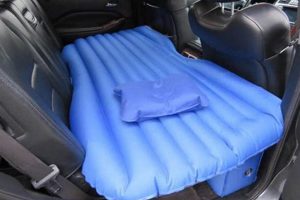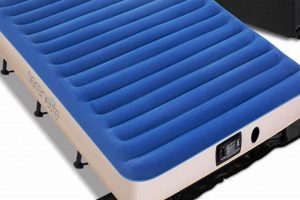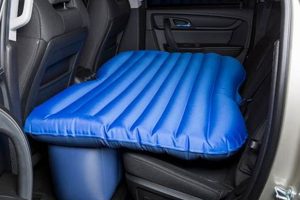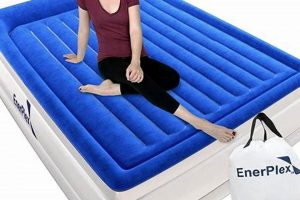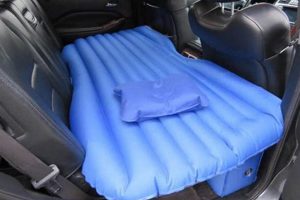The substance employed for mending punctures and tears in inflatable sleeping surfaces is typically a specialized adhesive. This product must exhibit flexibility, durability, and the ability to form a waterproof bond with the materials commonly used in air mattress construction, such as vinyl or PVC. For instance, a small tear near the seam of an inflatable bed can be effectively repaired using a suitable adhesive and a patch.
The application of such a product is essential for maintaining the functionality and longevity of inflatable sleeping solutions. Its use prevents air leakage, ensuring continued comfort and support. Historically, temporary solutions like tape were used, but these proved unreliable. Modern formulations provide a more permanent and robust repair, extending the usable lifespan of the mattress and reducing the need for replacements. This contributes to cost savings and reduces waste.
The following sections will delve into the specific types of adhesives used, the application techniques that yield the best results, and considerations for selecting the appropriate product for different types of damage and mattress materials. Furthermore, it will explore alternative repair methods and preventive measures to minimize the need for such repairs.
Guidance on Adhesive Application for Inflatable Mattresses
The following guidelines offer specific instructions for achieving durable and effective repairs using appropriate adhesives on inflatable mattresses. Adherence to these procedures will maximize the lifespan of the repaired item and prevent recurring leaks.
Tip 1: Surface Preparation: Thoroughly clean the area surrounding the puncture. Use isopropyl alcohol to remove any dirt, oil, or debris. A clean surface ensures optimal adhesive bonding.
Tip 2: Patch Material Selection: Choose a patch material compatible with the mattress’s composition (vinyl or PVC). Pre-cut patches designed for inflatable mattresses are readily available. The patch should extend at least one inch beyond the damaged area in all directions.
Tip 3: Adhesive Application: Apply a thin, even layer of the chosen adhesive to both the patch and the prepared surface of the mattress. Avoid excessive application, as this can weaken the bond.
Tip 4: Drying Time: Allow the adhesive to become tacky to the touch before applying the patch. Consult the adhesive manufacturer’s instructions for specific drying times. Premature application can result in a weak or ineffective seal.
Tip 5: Patch Placement: Carefully position the patch over the damaged area, ensuring complete coverage. Avoid trapping air bubbles beneath the patch.
Tip 6: Pressure Application: Apply firm, even pressure to the patch for several minutes. This ensures a strong bond between the patch and the mattress surface. A rolling pin or similar object can be used to distribute pressure evenly.
Tip 7: Curing Time: Allow the repaired area to cure for the recommended time period before inflating the mattress. This allows the adhesive to fully set and achieve maximum bond strength. Refer to the adhesive manufacturer’s guidelines for the recommended curing duration.
Tip 8: Leak Testing: After the curing period, partially inflate the mattress and check for leaks around the patched area. Apply a soapy water solution to the patch edges; bubbles indicate a leak. If a leak is detected, repeat the repair process.
Proper adhesive application, coupled with meticulous surface preparation and curing, ensures a long-lasting and reliable repair. This methodology minimizes air leakage and preserves the functionality of the inflatable mattress.
Subsequent sections will address advanced repair techniques and preventive maintenance strategies for inflatable mattresses.
1. Adhesive Type
The selection of the appropriate adhesive is paramount to the successful repair of inflatable mattresses. Diverse adhesive formulations exist, each possessing unique properties that dictate their suitability for specific repair scenarios. Understanding these distinctions is critical to achieving durable and lasting repairs.
- PVC Cement
Specifically formulated for bonding PVC materials, PVC cement chemically melts the surfaces together, creating a very strong and permanent bond. This is ideal for air mattresses made primarily of PVC, as it creates a weld rather than simply sticking two surfaces together. Improper use can damage the surrounding material, but a correct application yields superior results compared to other adhesive types.
- Vinyl Repair Adhesives
Designed for vinyl materials, these adhesives maintain flexibility and create a waterproof bond. They are effective for repairing smaller tears and punctures. Some formulas may include plasticizers to maintain vinyl’s pliability, preventing cracking or peeling over time. The strength of these bonds may be lower than PVC cement, however their flexible nature makes them ideal where stress is involved.
- Cyanoacrylate Adhesives (Super Glue)
While offering rapid bonding, cyanoacrylate adhesives generally exhibit poor flexibility and can become brittle over time. This makes them less suitable for inflatable mattress repair, as the material undergoes repeated inflation and deflation, stressing the adhesive bond. Cracking and eventual failure are common outcomes when using cyanoacrylate for this application.
- Polyurethane Adhesives
Polyurethane adhesives offer high strength and good flexibility, making them a viable option for certain air mattress repairs. They bond well to various materials and offer good water resistance. However, some polyurethane adhesives can be challenging to apply neatly, and proper surface preparation is crucial for optimal bonding. They are a strong alternative to PVC and Vinyl specific glues when dealing with more complex material types.
The long-term performance of repaired inflatable mattresses is directly linked to the chosen adhesive type. The careful evaluation of material compatibility, bond strength, and flexibility is vital in selecting the most appropriate adhesive for a given repair. Using the wrong adhesive, irrespective of application skill, can compromise the integrity of the repair and lead to premature failure, therefore it is essential to choose carefully.
2. Bond Strength
Bond strength is a critical characteristic of adhesives used to repair inflatable mattresses. It directly influences the durability and longevity of the repair. The adhesive’s ability to withstand the internal pressure exerted during inflation, coupled with the stresses of repeated use, determines the success or failure of the mend. Weak bond strength will inevitably lead to air leakage, requiring frequent re-applications or rendering the mattress unusable.
The required bond strength varies depending on the material of the mattress, the size and location of the damage, and the intended use of the inflatable. For instance, a large tear near a seam necessitates an adhesive with significantly higher bond strength than a small puncture in the center of the mattress. Similarly, an air mattress intended for heavy use or outdoor environments will require a more robust bond compared to one used infrequently indoors. Failure to consider these factors when selecting the appropriate adhesive can result in premature repair failure, even with meticulous application.
Ultimately, understanding the interplay between adhesive composition and bond strength is essential for effective air mattress repair. Selecting an adhesive formulated to provide a strong, flexible, and waterproof bond, suitable for the specific repair scenario, ensures the continued functionality and extended lifespan of the inflatable. This knowledge allows for informed decision-making, maximizing the utility of the repair efforts and minimizing the need for costly replacements. The following sections delve into the practical considerations for assessing and selecting adhesives based on their bond strength characteristics.
3. Material Compatibility
Material compatibility is a paramount consideration when selecting an adhesive for inflatable mattress repair. The chemical and physical interaction between the adhesive and the mattress material dictates the bond’s integrity and longevity. A mismatch can lead to weak adhesion, premature failure, and even damage to the mattress.
- PVC and Vinyl Adhesives
Air mattresses are predominantly constructed from PVC or vinyl. Adhesives specifically formulated for these materials contain solvents that slightly dissolve the surface, creating a chemical bond. Using a non-compatible adhesive on PVC or vinyl may result in a superficial bond prone to peeling and leakage. Examples include using general purpose glue on PVC, leading to an initial bond that weakens rapidly with inflation and deflation.
- Adhesion to Coated Fabrics
Some air mattresses feature coated fabric surfaces to enhance comfort or durability. The adhesive must bond effectively with both the coating and the underlying material. Adhesives that are too aggressive can damage the coating, while those that are too weak will fail to adhere properly. An example includes mattresses with a flocked top surface; aggressive solvents can dissolve the flocking, while weaker adhesives might not bond through it.
- Consideration of Plasticizers
PVC and vinyl often contain plasticizers to enhance flexibility. Over time, these plasticizers can migrate to the surface. An incompatible adhesive may not bond effectively to a surface containing plasticizers or may react negatively with them, leading to bond degradation. Specialized vinyl repair adhesives are formulated to resist the effects of plasticizer migration.
- Impact of Additives and Fillers
Air mattress materials may contain additives or fillers that affect the surface properties and adhesive bonding. Some fillers can create a porous surface, requiring adhesives with gap-filling capabilities. Additives, such as UV stabilizers, can sometimes interfere with adhesive bonding. Selection of an adhesive specifically designed to accommodate these variations is crucial.
In summary, the selection of the appropriate adhesive necessitates a thorough understanding of the air mattress material’s composition. Employing an adhesive with verified compatibility ensures a robust, durable, and lasting repair, maximizing the inflatable’s lifespan. Incompatibility can result in repair failure, material degradation, and ultimately, the need for replacement.
4. Water Resistance
The characteristic of water resistance is a critical factor influencing the efficacy and longevity of adhesives employed in air mattress repair. Inflatable mattresses are frequently subjected to damp or wet conditions, either through outdoor use, accidental spills, or cleaning procedures. An adhesive lacking adequate water resistance will degrade over time, leading to bond failure and subsequent air leakage.
- Hydrolytic Stability
Hydrolytic stability refers to the adhesive’s ability to withstand degradation caused by water exposure. Certain adhesive chemistries are susceptible to hydrolysis, a process where water molecules break down the polymer chains, weakening the bond. For air mattress applications, adhesives with high hydrolytic stability are essential. An example is a polyurethane-based adhesive specifically formulated for outdoor use, demonstrating superior resistance to moisture compared to a standard cyanoacrylate (super glue).
- Barrier Properties
The adhesive’s ability to act as a barrier against water penetration is also crucial. A porous or water-permeable adhesive allows moisture to reach the underlying substrate, promoting corrosion, mold growth, and eventual bond failure. Effective air mattress adhesives create a continuous, impermeable barrier. This is evident when comparing a PVC cement, which creates a waterproof weld, to a water-based craft glue, which readily absorbs moisture and fails to provide a lasting seal.
- Adhesion in Humid Environments
Many adhesives exhibit reduced bond strength in humid environments. Moisture can interfere with the bonding process, preventing the adhesive from properly wetting the surface and forming a strong bond. Air mattress adhesives should maintain adequate adhesion even under high humidity conditions. For instance, specialized vinyl repair adhesives often contain additives that promote adhesion in damp environments, ensuring a reliable repair even when used in humid climates.
- Resistance to Cleaning Agents
Air mattresses often require cleaning with water and mild detergents. The adhesive must be resistant to these cleaning agents to prevent bond degradation. Harsh chemicals can dissolve or weaken certain adhesives, leading to premature failure. A properly selected air mattress adhesive will withstand repeated cleaning cycles without compromising its structural integrity, allowing for regular maintenance without jeopardizing the repair.
In summary, the water resistance of adhesives is directly linked to the long-term performance of air mattress repairs. Selecting adhesives with high hydrolytic stability, effective barrier properties, strong adhesion in humid environments, and resistance to cleaning agents ensures a durable and reliable repair, extending the lifespan of the inflatable mattress and preventing recurring air leaks.
5. Application Method
The efficacy of any adhesive employed for air mattress repair is inextricably linked to the application method. The most advanced adhesive formulations will yield unsatisfactory results if not applied correctly. A meticulous approach to surface preparation, adhesive distribution, and curing is crucial for achieving a durable and lasting repair.
- Surface Preparation and Cleanliness
Proper surface
preparation is paramount for optimal adhesion. The area surrounding the damage must be thoroughly cleaned to remove dirt, oils, and any contaminants that may impede bonding. Isopropyl alcohol is often recommended as a cleaning agent. Abrasive cleaning may be necessary for certain materials or stubborn residues. Failure to adequately prepare the surface is a common cause of premature bond failure, as contaminants create a barrier between the adhesive and the mattress material. An example would be attempting to repair a dirty mattress in place, without first thoroughly cleaning the area around the hole. - Adhesive Distribution and Uniformity
The adhesive must be applied evenly and in a controlled manner. Excessive adhesive can weaken the bond by creating a thick, uneven layer that does not cure properly. Insufficient adhesive, conversely, may result in incomplete coverage and weak adhesion. A thin, uniform layer of adhesive is generally recommended. Tools such as small brushes or applicators can facilitate even distribution. An uneven application often leads to air pockets, resulting in areas of reduced bond strength and increased vulnerability to leaks.
- Pressure Application and Contact
After applying the adhesive and patch, firm and even pressure must be applied to ensure intimate contact between the patch and the mattress surface. This pressure facilitates proper bonding and eliminates air pockets. Clamps, weights, or rollers can be used to apply consistent pressure. The duration of pressure application should adhere to the adhesive manufacturer’s recommendations. Insufficient pressure leads to incomplete bonding and reduced strength, while excessive pressure can distort the patch or damage the mattress material.
- Curing Time and Environmental Factors
Adhesive curing is a critical process that allows the adhesive to achieve its full strength. The curing time varies depending on the adhesive formulation and environmental factors such as temperature and humidity. Premature use of the mattress before the adhesive is fully cured can compromise the bond. Adhering to the recommended curing time is essential. Environmental factors can significantly affect the curing process. High humidity can slow down the curing of certain adhesives, while extreme temperatures can affect the adhesive’s viscosity and bonding properties.
In conclusion, the application method is not merely a procedural step but an integral factor determining the success of air mattress repair. Proper surface preparation, even adhesive distribution, adequate pressure application, and adherence to curing guidelines are all essential for achieving a robust and durable bond. Overlooking any of these aspects can lead to a compromised repair, necessitating repeated interventions or rendering the mattress unusable. Therefore, a meticulous and informed approach to adhesive application is paramount for extending the lifespan of inflatable mattresses.
6. Curing Time
Curing time is an indispensable factor determining the ultimate strength and durability of repairs effected with air mattress adhesive. It represents the period required for the adhesive’s chemical components to fully react, cross-link, and achieve maximum bond strength. Inadequate curing time invariably leads to a weakened bond, rendering the repair susceptible to premature failure. Conversely, adhering to the recommended curing duration, as specified by the adhesive manufacturer, ensures the development of a robust and resilient seal, capable of withstanding the stresses of inflation, deflation, and regular use. For instance, a vinyl repair adhesive requiring 24 hours of curing time may exhibit a weak bond if inflated after only 12 hours, whereas allowing the full curing period will result in a significantly stronger and more durable repair.
The specific curing time is inherently linked to the composition of the adhesive. Different chemical formulations necessitate varying durations for complete cross-linking. Environmental conditions, specifically temperature and humidity, also influence the curing rate. Elevated temperatures generally accelerate the curing process, while low temperatures and high humidity can retard it. Therefore, it is essential to consider these environmental factors and adjust the curing time accordingly. For example, a PVC cement that cures in 2 hours at 70F might require 4 hours or longer at 50F. Practical application involves carefully monitoring the ambient conditions and adhering to the adhesive manufacturer’s guidelines for optimal curing under those specific circumstances.
In summary, curing time is not merely a temporal constraint but a critical component of the adhesive’s performance. Its understanding and diligent adherence are paramount to achieving reliable and lasting air mattress repairs. Disregarding the recommended curing time compromises the bond strength and jeopardizes the integrity of the repair. Proper consideration of the adhesive’s formulation, environmental factors, and adherence to the specified curing duration is essential for maximizing the lifespan of the repaired inflatable mattress. Neglecting this aspect diminishes the effectiveness of the chosen adhesive.
Frequently Asked Questions About Air Mattress Glue
The following addresses common inquiries regarding the use of adhesives in repairing inflatable mattresses, providing factual information to guide proper application and selection.
Question 1: What type of adhesive is most suitable for repairing an air mattress?
The optimal adhesive depends on the mattress material. PVC-specific cements are preferred for PVC mattresses, offering superior bonding. Vinyl repair adhesives are appropriate for vinyl surfaces, maintaining flexibility. Cyanoacrylate adhesives (super glue) are generally not recommended due to their brittleness and tendency to fail under stress.
Question 2: How does surface preparation affect the success of air mattress repair with adhesive?
Thorough surface preparation is crucial. The area surrounding the damage must be cleaned to remove dirt, oils, and debris. Isopropyl alcohol is effective for this purpose. Inadequate surface preparation impedes adhesion and increases the risk of repair failure.
Question 3: What is the significance of curing time when using adhesive on an air mattress?
Curing time allows the adhesive to fully bond and achieve maximum strength. Adhering to the manufacturer’s recommended curing time is essential. Premature use of the mattress before the adhesive is fully cured can compromise the bond and lead to air leaks.
Question 4: Is water resistance an important factor to consider when selecting an air mattress adhesive?
Yes, water resistance is a critical factor. Inflatable mattresses are frequently exposed to moisture. An adhesive lacking water resistance will degrade over time, leading to bond failure. Adhesives with high hydrolytic stability and good barrier properties are preferred.
Question 5: Can excessive adhesive application improve the bond strength on an air mattress repair?
No, excessive adhesive application is detrimental. A thin, even layer of adhesive is optimal. Excessive adhesive can weaken the bond by creating a thick, uneven layer that does not cure properly. It can also trap air and cause uneven drying.
Question 6: How should pressure be applied during the air mattress repair process?
Firm and even pressure should be applied to the patch during the curing process. This ensures intimate contact between
the patch and the mattress surface, facilitating proper bonding and eliminating air pockets. Clamps, weights, or rollers can be used to apply consistent pressure.
In summary, the selection and application of adhesives for air mattress repair demand careful consideration of material compatibility, surface preparation, curing time, and environmental factors. Adherence to best practices ensures a durable and lasting repair, extending the lifespan of the inflatable mattress.
The following sections will discuss preventative measures and long-term maintenance strategies for inflatable mattresses.
Air Mattress Glue
This discourse has explored the multifaceted aspects of air mattress glue, emphasizing its critical role in the maintenance and longevity of inflatable mattresses. Discussions encompassed adhesive types, bond strength, material compatibility, water resistance, application methods, and curing times, each element contributing significantly to repair efficacy. Adherence to best practices in adhesive selection and application remains paramount for successful and durable repairs.
The judicious use of appropriate air mattress glue can extend the lifespan of these products, reducing waste and minimizing replacement costs. Understanding the nuances of adhesive technology empowers informed decision-making, fostering responsible consumption and promoting sustainable practices. Further research into advanced adhesive formulations and application techniques holds the potential to further enhance the effectiveness and durability of inflatable mattress repairs, solidifying the importance of ongoing innovation in this field.



